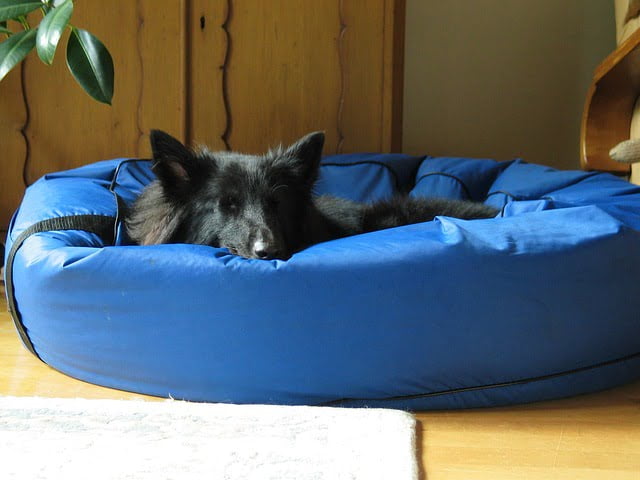How long does a dog bed last?
 As a dog owner, you want to ensure your furry friend has a comfortable and supportive place to rest their head. A dog bed is an essential item for any pet owner, providing a cozy spot for your dog to relax and sleep. However, the question that many pet owners have is: how long does a dog bed last?
As a dog owner, you want to ensure your furry friend has a comfortable and supportive place to rest their head. A dog bed is an essential item for any pet owner, providing a cozy spot for your dog to relax and sleep. However, the question that many pet owners have is: how long does a dog bed last?
The lifespan of a dog bed can vary based on several factors, such as the quality of materials used, frequency of use, type of bed, size and weight of your dog, and cleaning and maintenance habits. Understanding these factors can help you determine how long your dog’s bed may last and when it’s time to replace it.
In this article, we will discuss the various factors that affect the lifespan of a dog bed, the different types of dog beds available, signs that your dog bed may need replacement, and tips for maintaining and extending the lifespan of your dog’s bed. By the end of this article, you’ll have a better understanding of how long your dog’s bed can last and how to ensure it stays in top condition for as long as possible.
How long does a dog bed last?
On average, a good-quality dog bed can last anywhere from 2 to 5 years. However, some dog beds may last longer, while others may need to be replaced sooner.
Factors that affect the lifespan of a dog bed
The lifespan of a dog bed can be influenced by a variety of factors. Some of the most important factors that can affect how long a dog bed lasts include:
Quality of materials
The quality of materials used in the construction of a dog bed can play a significant role in how long it lasts. Higher-quality materials such as memory foam, durable fabrics, and supportive fillings like orthopedic foam can make a bed more resistant to wear and tear and can increase its lifespan.
Frequency of Use
The more often a dog bed is used, the more quickly it will wear out. If your dog spends a lot of time in their bed or if you have multiple dogs sharing the same bed, it may wear out faster than a bed that is used less frequently.
Type of bed
Different types of dog beds may have different lifespans. For example, a raised bed may last longer than a soft cushion-style bed because it is less likely to compress over time. Similarly, a bed with a removable cover may be easier to clean and maintain, leading to a longer lifespan.
Size and Weight of Your Dog
Larger and heavier dogs may put more strain on a dog bed, causing it to wear out more quickly. Additionally, dogs that are more active or have a tendency to dig or scratch may cause more wear and tear on their beds.
Cleaning and maintenance habits
Proper cleaning and maintenance can help extend the lifespan of a dog bed. Regularly washing the cover, vacuuming the filling, and keeping the bed in a clean and dry area can prevent odors and stains from building up, which can shorten the lifespan of the bed.
Understanding these factors can help you choose a high-quality dog bed that is suitable for your dog’s needs and will last as long as possible.
Lifespan of an Orthopedic Dog Bed
Generally, the lifespan of an orthopedic dog bed can vary depending on several factors, as stated above, such as the quality of the materials used, the frequency of use, and the size and weight of your dog. However, on average, a good-quality orthopedic dog bed can last anywhere from 3–5 years.
Signs that your dog bed needs replacement
Your dog’s bed is an important investment in their health and well-being, and it’s essential to ensure that it continues to provide the necessary comfort and support over time. Here are some signs that your dog bed needs replacement:
Loss of shape and support
Over time, the filling in your dog’s bed can become compressed or lose its shape, making the bed less supportive and comfortable for your dog. If the bed no longer holds its shape or has flattened areas, it’s time for a replacement.
Damage to the bed’s covering
Your dog’s bed may sustain damage over time due to wear and tear, chewing, or scratching. If you notice holes or tears in the bed’s covering, it can be a safety hazard for your dog and may expose them to the filling material inside.
Unpleasant odors
If your dog’s bed emits unpleasant odors, it may be a sign of bacteria or mold growth. This can pose a risk to your dog’s health and should be addressed immediately by replacing the bed.
Allergy or skin irritation
If your dog develops allergy symptoms or skin irritation, it could be due to an accumulation of allergens or bacteria in their bed. This can also be a sign that the bed needs replacement.
Your dog has outgrown their bed
As your dog grows and ages, their size, weight, and sleeping habits may change. If you notice that your dog no longer fits comfortably on their bed or is no longer using it, it may be time to upgrade to a new bed.
By keeping an eye out for these signs and regularly assessing the condition of your dog’s bed, you can ensure that your dog always has a comfortable and supportive place to rest.
Tips for maintaining and extending the lifespan of your dog’s bed
To ensure that your dog’s bed lasts as long as possible and continues to provide the necessary support and comfort, here are some tips for maintaining and extending its lifespan:
Wash the cover regularly
Regularly washing the bed’s cover can help prevent the buildup of dirt, oils, and bacteria, which can cause odors and wear down the cover over time. Follow the manufacturer’s instructions for washing and drying the cover.
Use a waterproof liner
Using a waterproof liner can help protect the bed’s filling from moisture and accidents, which can cause it to break down faster. A waterproof liner can also make cleaning the bed easier.
Rotate the bed
Rotating the bed periodically can help distribute wear and tear more evenly and prevent the bed from developing lumpy or flattened areas.
Avoid using harsh chemicals
Harsh chemicals such as bleach or fabric softeners can damage the bed’s cover and filling material. Use mild detergents and avoid using fabric softeners.
Keep the bed in a dry, cool area
Keeping the bed in a dry, cool area can help prevent mold and mildew growth and prolong the bed’s lifespan.
Trim your dog’s nails
Your dog’s nails can scratch and damage the bed’s cover and filling material. Regularly trim your dog’s nails to prevent this from happening.
Frequently Asked Questions
What type of dog bed lasts the longest?
Orthopedic dog beds made from high-quality materials typically last the longest. Memory foam or latex foam beds with a durable, removable cover can last up to five years or more with proper maintenance.
What should I do with my old dog bed?
If your old dog bed is still in good condition, consider donating it to a local animal shelter or rescue organization. If the bed is damaged or worn, dispose of it responsibly.
Can I wash my dog’s bed in the washing machine?
Whether or not you can wash your dog’s bed in the washing machine will depend on the bed’s material and the manufacturer’s instructions. Some beds can be washed in the washing machine, while others require hand washing or professional cleaning. Always follow the manufacturer’s instructions for washing and drying your dog’s bed.
What type of filling material should I choose for my dog’s bed?
The filling material you choose for your dog’s bed will depend on your dog’s needs and preferences. Memory foam, orthopedic foam, and polyester fiberfill are common options. Memory foam and orthopedic foam are best for dogs with joint or mobility issues, while polyester fiberfill is a more affordable option.
What size dog bed should I buy?
The size of the dog bed you should buy depends on the size and breed of your dog. A good rule of thumb is to measure your dog from nose to tail and add 6–12 inches. This will give you a rough idea of the size of bed you should buy.
Conclusion
In conclusion, a dog bed is an essential item for your furry friend’s comfort and well-being. Knowing how long a dog bed lasts and the factors that affect its lifespan can help you make an informed decision when choosing a bed for your dog.


